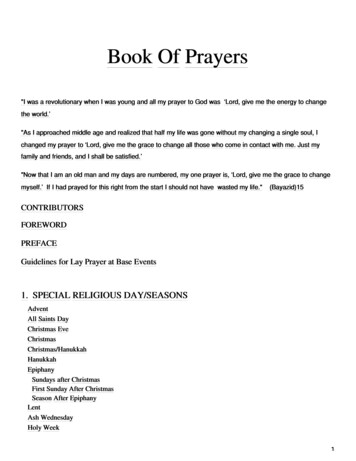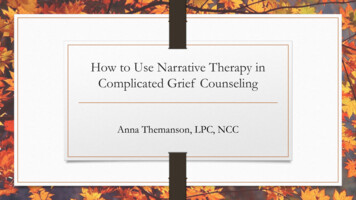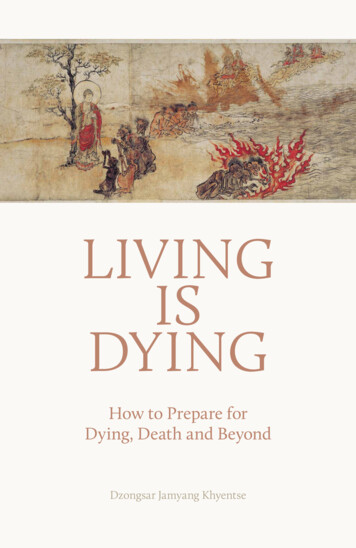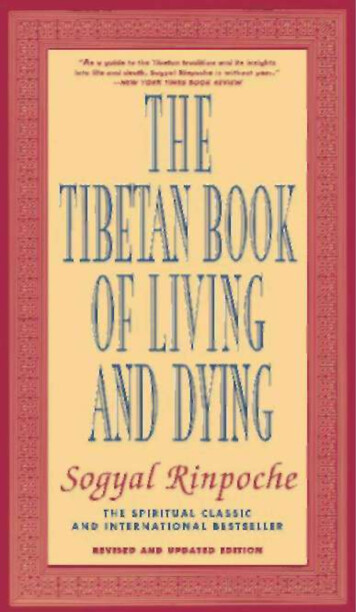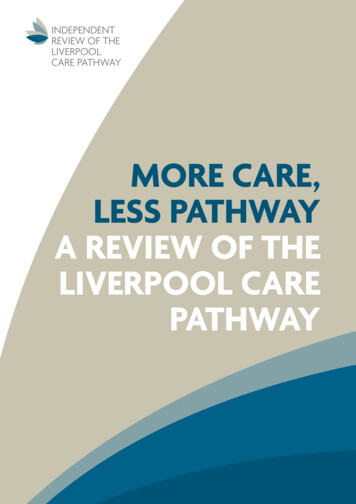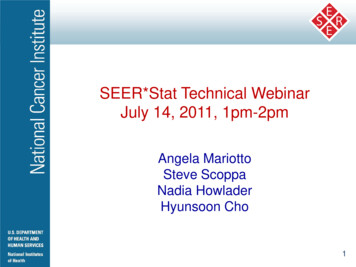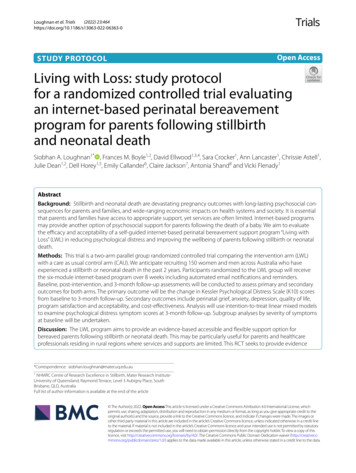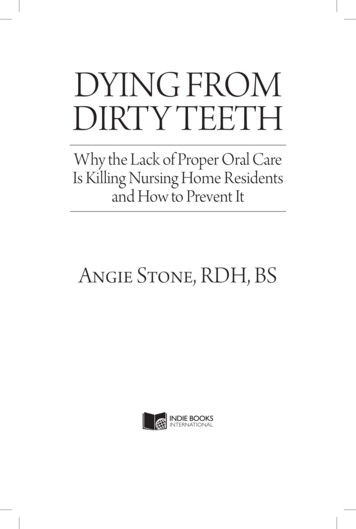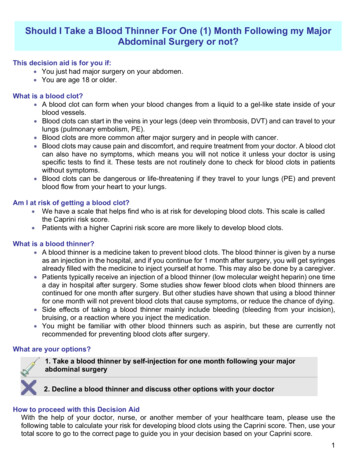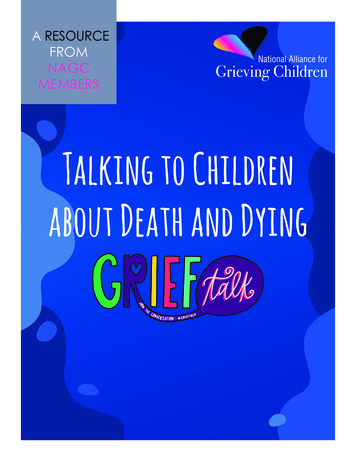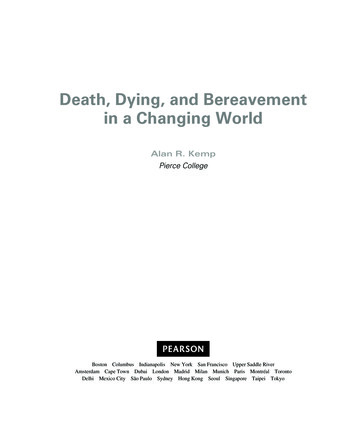
Transcription
Death, Dying, and Bereavementin a Changing WorldAlan R. KempPierce CollegeBoston Columbus Indianapolis New York San Francisco Upper Saddle RiverAmsterdam Cape Town Dubai London Madrid Milan Munich Paris Montréal TorontoDelhi Mexico City São Paulo Sydney Hong Kong Seoul Singapore Taipei TokyoA01 KEMP0760 01 SE FM.indd 116/11/13 1:34 AM
Editor in Chief: Ashley DodgePublisher: Nancy RobertsEditorial Assistant: Molly WhiteDirector of Marketing: Brandy DawsonExecutive Marketing Manager: Kelly MaySenior Marketing Coordinator: Courtney StewartManaging Editor: Denise ForlowProgram Manager: Mayda BoscoProject Manager: Kristen Jobe, IntegraSenior Operations Supervisor: Mary FischerOperations Specialist: Diane PeiranoArt Director: Jayne ConteCover Designer: Salzbach, KarenCover Image: MassonDirector of Digital Media: Brian HylandDigital Media Project Management: Learning MateSolutions, Ltd./Lynn CohenDigital Media Project Manager: Tina GagliostroFull-Service Project Management andComposition: Integra Software Services Pvt. Ltd.Printer/Binder: Courier Corp.Cover Printer: Courier Corp.Text Font: 11/13, Times LT StdCredits and acknowledgments borrowed from other sources and reproduced, with permission, in this textbook appear on appropriate page within text.Copyright 2014 by Pearson Education, Inc. All rights reserved. Printed in the United Statesof America. This publication is protected by Copyright and permission should be obtained fromthe publisher prior to any prohibited reproduction, storage in a retrieval system, or transmission inany form or by any means, electronic, mechanical, photocopying, recording, or likewise. To obtainpermission(s) to use material from this work, please submit a written request to Pearson Education,Inc., Permissions Department, One Lake Street, Upper Saddle River, New Jersey 07458 or you mayfax your request to 201-236-3290.Many of the designations by manufacturers and seller to distinguish their products are claimed as trademarks. Where those designations appear in this book, and the publisher was aware of a trademark claim,the designations have been printed in initial caps or all caps.Library of Congress Cataloging-in-Publication DataKemp, Alan R.Death, dying, and bereavement in a changing world / Alan R. Kemp, Pierce College.pages cmIncludes bibliographical references and index.ISBN-13: 978-0-205-79076-0 (alk. paper)ISBN-10: 0-205-79076-3 (alk. paper)1. Thanatology. 2. Death. 3. Bereavement. I. Title.HQ1073.K46 2014306.9—dc23 201301678910 9 8 7 6 5 4 3 2 1ISBN-10:0-205-79076-3ISBN-13: 978-0-205-79076-0A01 KEMP0760 01 SE FM.indd 216/11/13 1:34 AM
Preface xiiAbout the Author xxPart IContentsIntroduction and Context1Chapter 1 Lifting the Pall: The Quest to Uncover Wisdom about Life Through theStudy of Death 4 BOX 1.1: The Object Exercise 5About Self-Care 5Lifting the Pall 6Interchangeable Parts7Death Education 8Growth of Contemporary Death Studies 8A Multidisciplinary, Multidimensional Emphasis in the Field 10Theory, Research, and Practice 12The Theory-Research Cycle 12Diverse Research Methods 14What about the Denial of Death? 15Empirical Evidence and Key Elements 18Implications 19 BOX 1.2: Focus on Practice: Helping People Cope with the Reality of theirFinitude 19Chapter Summary 20 Key Terms 20 SuggestedActivities 21 Suggested Reading and Viewing 21 Links andInternet Resources 21 Review Guide 22Chapter 2 Death and Dying in a Rapidly Changing World23Advances in Medicine 25Western Experience 27Modern Trends 29 BOX 2.1: The Baal Shem Tov and the Doctor31A Changing World 32Industrial Revolution and Modernity 33Quantum Change 34Changing Attitudes 36Professional Attitudes 36Professional Socialization 38Technology Dependence 39The Research Imperative 40The Human Imperative: Competence in End-of-Life Care 40iiiA01 KEMP0760 01 SE FM.indd 316/11/13 1:34 AM
ivContentsChapter Summary 42 Key Terms 42 SuggestedActivities 43 Suggested Reading 43 Links and InternetResources 44 Review Guide 44Chapter 3 For Everything There Is a Season: The Developmental Context 45Children’s Deaths 46Newborns 47Toddlers 48The Death of Eli Creekmore 49Middle Childhood 49Learning about Death 49Cognitive Development 50Children’s Understanding of Death 51A World of Seriously Ill Children 53Helping Children Cope 53 BOX 3.1: Focus on Practice: Using Creative Therapies 54Death among Youth 56The Shot Went Straight to the Heart56Death in Adulthood 57Social Development 57Life’s Final Stage 62Chapter Summary 63 Key Terms 64 SuggestedActivities 64 Suggested Reading 65 Links and InternetResources 65 Review Guide 66Chapter 4 Coureurs de Bois: Cross-Cultural and Interfaith Dimensions 67Conceptual Tools 68 BOX 4.1: From Your Place in the Circle 69Culture, Spirit, and Death 70Culture and Spirit 70Spirit and Death 74Key Religious Perspectives 74Abrahamic Tradition 75Hinduism and Buddhism 76The Hero’s Quest 76Chautauqua 78The Call of the Owl 78The Dalai Lama Speaks about Life and Death 79Los Dias de Muertos 81Mejo Ma and the Dilemma of Maya 83Near the Burning Ghat 84Reunion with Allah 85A01 KEMP0760 01 SE FM.indd 416/11/13 1:34 AM
ContentsvChapter Summary 86 Key Terms 87 SuggestedActivities 87 Suggested Reading 88 Links and InternetResources 88 Review Guide 88Part IIDeath91Chapter 5 The Grim Reaper through Time: A Historical and Cross-Cultural Lookat Undertaking 93Historical Undertaking 94Ancient Egyptian Funerary Customs 95Civil War Roots of Modern Undertaking 95Modern Embalming 96Trends in Burial and Cremation 98Simple and Cheap100Cremation 102State of the Art 103 BOX 5.1: Focus on Practice: Dealing with Death 103Commemorative Customs 104Jewish Custom 106Christian Tradition 107Islamic Tradition 108Hindu Tradition 108Buddhist Customs 109Chapter Summary 110 Key Terms 111 SuggestedActivities 111 Suggested Reading 112 Links and InternetResources 112 Review Guide 113Chapter 6 The Grim Reaper Today: Emerging Trends in Contemporary“Deathcare” 114Our Changing Death System 114Commercialization of Death 117Death, Incorporated 117Cemeteries and Crematories Loopholes 121Industry Perspective 121Flashback 122Window into the Past 122Alternative Death Movement 124Funeral Consumers’ Advocacy 124Home Funerals 125We Wanted to Keep Him with Us . . .126Green Burial 126A01 KEMP0760 01 SE FM.indd 516/11/13 1:34 AM
viContentsChapter Summary 128 Key Terms 129 SuggestedActivities 129 Suggested Reading and Viewing 129 Links andInternet Resources 130 Review Guide 131Chapter 7 Traumatic Death 132Trauma and Traumatic Death 133Terrorism 133Terrorism: Foreign and Domestic 133Understanding the Events of September 11, 2001 136Unresolved Questions Arising from the Boston MarathonBombings 137Suicide 137Impact of Suicide 138Tomorrow Never Came 138Explanations of Suicide 139Suicide Awareness 144Preventing Suicide 144Survivors of Suicide 145Homicide 146Smoke Him147HIV/AIDS Pandemic 148Early Days of the AIDS Pandemic 149The Progression of HIV/AIDS 149AIDS Lethality 150St. Christopher’s House 151The Anti-HIV Drugs 151Complacency Creates New Dangers 152Chapter Summary 152 Key Terms 153 SuggestedActivities 154 Suggested Reading 154 Links and InternetResources 154 Review Guide 155Part III Dying157Chapter 8 In the Valley of the Shadow: Facing Death 159Walking in the shadow 160The Messengers of Death 161The Course of Dying 162Dying Trajectories 162Morrie SchwartzA01 KEMP0760 01 SE FM.indd 616416/11/13 1:34 AM
ContentsviiDealing with Life-Threatening Illness 164Prognosis 165Kübler-Ross’s Stages 166Critiques of the Model 168Task-Based Approach 170Spiritual Pain 172Hope 172Living in the Light 173Lessons from the Angel of Death 174Life Insurance, Wills, and Trusts 175 BOX 8.1: Focus on Practice: Dealing with the Dimensions of Dying 177Chapter Summary 178 Key Terms 179 SuggestedActivities 179 Suggested Reading and Viewing 179 Links andInternet Resources 180 Review Guide 181Chapter 9 Intensive Caring: Hospice and Palliative Care182Changing Philosophies 183The Hospice Story 184Hospice Heritage 184Modern Hospice 185Hospice in North America 186Palliative Care 187Palliative Medicine 188Spread of Programs 188Convergence 190The Hospice Team 191Providing End-of-Life Care 192What Hospice and Palliative Care Actually Do 192The Experience of Pain 192Concerns about Addiction 194Other Physical Symptoms and Their Treatment 194Providing Psychological, Social, and Spiritual Care 196World with Good Death? 197Advance Directives, Living Wills, Medical Powers of Attorney, and DoNot Resuscitate Orders 197Some Present-Day Realities 198Eligibility, Access, and Referral 199Falling through the Cracks 201Medicare 201I Didn’t Even Know What Hospice Was 201Medicaid 202A01 KEMP0760 01 SE FM.indd 716/11/13 1:34 AM
viiiContentsOn the Horizon 203Chapter Summary 204 Key Terms 204 SuggestedActivities 204 Suggested Reading 205 Links and InternetResources 206 Review Guide 207Part IVBereavement, Grief, and Mourning209Chapter 10 Life after Loss: Bereavement, Grief, and Mourning 211Core Concepts 212Grief Work 213Freudian Perspective 214Stages of Grief 214Broken Bonds 214The Work of Colin Murray Parkes 215A Task-Based Approach 218Having One’s Child Die 218Cowboy in the Sky 220Shifting Paradigms 222Problems with the Grief-Work Paradigm 223Broken Bonds or Broken Hearts? 223Challenging Prevailing Theory and Clinical Lore 224Quest for an Integrated Framework 224What We’ve Learned 225Consensus in Bereavement Research 225Significance for Helpers 226New Knowledge 226The Work of George Bonanno 226Dual-Process Model 228Mourning 229Telling the Tale 232 BOX 10.1: An Important Person Who Has Died 233Chapter Summary 234 Key Terms 235 SuggestedActivities 235 Suggested Reading 235 Links and InternetResources 236 Review Guide 237Chapter 11 When Grief Goes Awry: Complicated Grief 238Nature of the Beast 239Traumatic Loss 242Pebbles in the Pond 242Early Research on Traumatic Grief 244A01 KEMP0760 01 SE FM.indd 816/11/13 1:34 AM
ContentsixAssessing Reactions to Traumatic Loss 244Dealing with Traumatic Reactions 246Prolonged Grief 248Risks and Risk Factors 249Personal Risk Factors 250Religiosity 251Gender 251Age 251Interpersonal Factors 252Attachment Theory 252Disenfranchised Grief 252Coping 253Emerging Models 254Complicated Grief Treatment 254 BOX 11.1: Treating Complicated Grief 255Meaning and Story 255“Storying” 257Chapter Summary 258 Key Terms 260 SuggestedActivities 260 Suggested Reading 260 Links and InternetResources 261 Review Guide 261Part VLegal and Ethical Borderlands 263Chapter 12 Physician-Assisted Suicide and Euthanasia 265As Long as One Person Remembers 266Core Concepts 266The Kevorkian Debate 267One-Man Campaign of “Dr. Death” 267The Law and Hastened Death 268By All Accounts He Was a Tough Man 270Unintentional Overdose 271The Principle of Double Effect 271Illicit Hastened Death 271Voluntary Euthanasia 272Dr. Rob Jonquiere: An Intensely PersonalExperience 273Dr. Theo A. Boer: Maybe How We Die IndicatesHow We Live 274Herman H. Van der Kloot Meijburg: Not Only Is It You Who’s Dying,But We Will Have to Take Leave of You 275A01 KEMP0760 01 SE FM.indd 916/11/13 1:34 AM
xContentsMoral and Ethical Concerns 276Professional Profile: Ezekiel J. Emanuel, M.D., Ph.D. 277Chapter Summary 279 Key Terms 280 SuggestedActivities 280 Suggested Reading and Viewing 280 Links andInternet Resources 280 Review Guide 281Chapter 13 Withdrawing Life Support and Organ Transplantation282Defining Death 282Miracle in South Africa: The First Heart Transplant 283Transplantation and Ethics 284The Dead Donor Rule 284The Harvard Criteria 284Uniform Death Determination Act 285Brain Stem Criteria 286Neocortical Criteria 286He Was the Center of Everything 289Transhumanist Revolution? 290Withdrawing Life Support 291The Case of Karen Ann Quinla 291Medical Futility 296Withdrawing Life Support from the Actively Dying 298Chapter Summary 302 Key Terms 302 SuggestedActivities 303 Suggested Reading 303 Links and InternetResources 303 Review Guide 304Part VIInto the Future 305Chapter 14 Life after Life307Ancient Egyptian Beliefs 307Tibetan Buddhist Teachings 310Abrahamic Tradition 312Semitic Traditions 312Evolution of Jewish Beliefs about the Afterlife 313Christian Beliefs about the Afterlife 314Islamic Beliefs 316The Near-Death Experience 317Distressing Near-Death Experiences 319Kübler-Ross’s Thinking about Life After Death 320Science and the Near-Death Experience 321A01 KEMP0760 01 SE FM.indd 1016/11/13 1:34 AM
ContentsxiChapter Summary 324 Key Terms 324 SuggestedActivities 325 Suggested Reading 325 Links and InternetResources 325 Review Guide 326Chapter 15 The Road Ahead 327Modern Trends 328Sequestration 328Secularization 329Our Dad Jack331Desecularization 331X-ers, Nexters, and Texters 333How We Are Dying 339End-of-Life Caring 340Learning to Live Until We Die 341The Long Good-Bye 342Chapter Summary 345 Key Terms 346 SuggestedActivities 347 Suggested Reading 347 Links and InternetResources 348 Review Guide 348Glossary 350References 363Index 399A01 KEMP0760 01 SE FM.indd 1116/11/13 1:34 AM
PrefaceDeath, dying, and bereavement are different today than in times past. As Dorothy in theWizard of Oz said, “I don’t think we’re in Kansas anymore, Toto.” Before modernization,life was different. Industrialization ushered in a new world of technology. Today, we arearguably on the cusp of yet another change, a postmodern world, in which informationtechnology, globalization, and new ways of relating loom big. The world in which welive has changed. “Back in the day,” as they say, someone might reasonably expectto die the “good death,” at home, cared for by family and friends. With the arrival ofindustrialization and advances in medical technology, it has become far more likely todie in a hospital or nursing home, surrounded by the latest medical technology.Today, we are not always even sure what death is. Do we mean being “clinically dead”—unable to breathe on one’s own and have a heart that is still beating?Or do we mean “brain dead,” sometimes called being a “heart-beating cadaver”?When I began working on this project I felt there was a need for a book that tried toprovide a context for understanding our changing encounters with death, dying, andbereavement.I also believed there was a need for a book that helps students integrate the variousdimensions of experience with death, dying, and bereavement. Indeed, s omethingelse I am very concerned about is assisting readers in understanding the topic froma multidimensional perspective. This includes approaching it in an integrated way, looking at the physical, social, psychological, and spiritual dimensions.Ernest Becker (1973) is credited with coining the term denial of death to describemodern-day attitudes toward death. To use the term denial also implies that we humanbeings are somehow at odds with consciousness about the unpleasant reality of death.Although it may be true that human societies engage in all kinds of practices that aredesigned to protect us from coming too close to this grim eventuality, death’s profoundpresence is never very far away. Regardless of how we choose to relate to it, death isthat most universal of all human experiences.People in all places and at all times have found ways to relate to death and dying.Beliefs, attitudes, and practices about the end-of-life issues are integral to virtuallyall human cultures. In the modern technological world in which we live here in NorthAmerica, there exists a highly evolved system of health care that attempts to combatdisease of all kinds and ward off death. Our educational system is rooted in a model of“scientific empiricism” that demands that we try to control the variables we study inorder to establish cause-and-effect relationships between them. Because of advancesin knowledge, technology, and medicine, life expectancy has been increased to a remarkable degree, at least in the technologically advanced parts of the world.Modern approaches to mental health and self-help promote ways to help peopleget the most out of life and live it to its fullest. Despite all this, the end of life remains apervasive part of the human experience. It is not my intent to be morbid in what I havexiiA01 KEMP0760 01 SE FM.indd 1216/11/13 1:34 AM
Prefacexiiisaid here. Life is rich, and precious, and wonderful. It is to be appreciated all the morebecause our days are numbered. The possibilities in life are replete and its dimensionsare many. I hope we can find ways to bridge gaps in our understanding and integratewhat we know about life and its counterpart, death. To do so, we explore the relationships that exist between the many facets of living and dying. For me, this means delvinginto beliefs and meaning; aspirations and what people feel drawn to; human experienceand emotion; courage, hope, and growth; ritual and spiritual practices; what it means tolive in the fellowship of communities; and what it means to exist within the social institutions that are so integral to our society.What Is in This Book?Death, Dying, and Bereavement in a Changing World has six parts and a total of fifteenchapters. Part I has four chapters that provide an introduction and context. Chapter 1opens with the topic of “lifting the pall.” The pall, a cloth placed over the casket during a funeral, is a metaphor for “denial of death,” the title of the Pulitzer Prize– winningbook by Ernest Becker. The text introduces thanatology, the study of death, dying,and bereavement; reviews key events in the development of the field; discusses the multidisciplinary nature of the field; introduces the four-facet model (physical, social,psychological, and spiritual dimensions); and explores the present-day conversationbetween theory, research, and practice. Chapter 2 focuses on our changing experienceas shaped by society, science, and technology. Whereas in times past people ideally diedat home, surrounded by friends and family, today seven out of ten people die in a hospital or nursing home. Science has increased average life expectancy by 30 years in just acentury, and our industrialized and bureaucratized health-care system has changed howwe die. In Chapter 3, we will look at death and human development, exploring encounters with death across the life span, the nature of children’s consciousness about death,and what happens when the life cycle naturally concludes. Chapter 4 focuses on crosscultural and interfaith dimensions. The title begins with Coureur de Bois, a FrenchCanadian term denoting the idea of travelers sharing stories about all the places theyhave been and things they have seen. We will look at the relationship between culture,spirit, and death; review theoretical perspectives on the role of spirituality and religion;and survey five key religious perspectives.The three chapters of Part II examine death itself. Chapter 5 takes a historical andcross-cultural look at the business of undertaking. It begins with a discussion of clinical death and looks at what happens when the heart stops beating, breathing stops, thebody cools, rigor mortis sets in, and the body begins to decay. The text reviews burialpractices from ancient times to the emergence of the modern “funeral service industry.” Chapter 6 begins with a discussion of our contemporary “death system” but alsoexplores criticisms of “McDeath,” the corporate commercialization of death. It exploresthe use and abuse of the Amended Funeral Rule. It also examines alternatives: funeralconsumers’ societies, home funerals, and green burial. Chapter 7 addresses traumaticA01 KEMP0760 01 SE FM.indd 1316/11/13 1:34 AM
xivPrefacedeath—that is, death that is sudden, violent, and/or inflicted. Within this context, wewill explore death from murder, suicide, terrorism, and pandemics, such as AIDS.Part III is concerned with dying, or the process of getting dead. It has two chapters.Chapter 8 looks at what is involved in facing death and what it means to make the transition from feeling “temporarily immortal” to being “terminal.” The chapter discussesElisabeth Kübler-Ross’s classic stages of dying and Dr. William Bartholome’s experience with the “Angel of Death,” and examines “death trajectories.” In Chapter 9 youwill learn about “intensive caring,” the term I use when discussing modern hospice andpalliative care—the “gold standard” when it comes to end-of-life care. We will discussits evolution and key players. As our discussion draws to a close, we will explore thepitfalls and falling through the cracks.Part IV, which focuses on bereavement, grief, and mourning, has two chapters.Chapter 10 considers the “normal” bereavement, grief, and mourning. We will look atthe classic “grief work” model first articulated by Sigmund Freud and further developedby a whole generation of theorists. Then we will explore the “new science of bereavement research,” which may be turning the old ideas on its head. Chapter 11 focuses oncomplicated grief—what happens when grief is experienced too intensely or for toolong. We will investigate the evidence that supports innovative approaches to treatment.Part V contains two chapters that deal with the legal and ethical borderlands.Chapter 12 explores physician-assisted suicide and euthanasia. You will learn that physician-assisted suicide is now legal in Oregon and Washington state and is tolerated inMontana. Typically, the physician prescribes a drug the patient takes to end his or herlife. Some patients, however, such as those suffering from Lou Gehrig’s disease, maynot be able to act on their own. This is the segue to discussion of the issue of voluntaryeuthanasia, what happens when someone else takes steps to end the life of a patient whowants to die. Although illegal in all U.S. jurisdictions, it is tolerated in the Netherlands,Belgium, and Luxembourg. Chapter 13 addresses the issues of withdrawing life- supportsystems and organ transplantation. The text reviews “brain death” and harvesting humanorgans, and discusses what to do when a person is in a “persistent vegetative state,”“coma,” or “locked-in syndrome.”Part VI contains two chapters. Chapter 14 addresses a single question, but it is abig one: What happens after we die? According to terror management theory (TMT), discussed in Chapter 1, human beings are different from other animals in that we canconceptualize our own deaths, leading to death anxiety and a host of other problems.Also according to this theory, we have come up with two strategies to deal with it: culture (including the use of religion) and self-efficacy, or the sense of personal empowerment. Most religions tell us that part of us survives death. In this chapter, we willexplore in some detail what the various religious traditions say about life after life.We will also contemplate speculations based on the so-called near-death experience.Chapter 15 looks at what is ahead. It reviews the current trends in death, dying, andbereavement and speculates on the future, including the experiences of the “X-ers,”“Nexters,” and “Texters.”A01 KEMP0760 01 SE FM.indd 1416/11/13 1:34 AM
PrefacexvHolistic and Integrated ApproachThe field of thanatology is multidimensional and multidisciplinary. It is an enterprisethat strives to integrate diverse perspectives and facets of life (Corr, 1992; CanadianHospice Palliative Care Association, 2004; Ferris et al., 2002; Last Acts, 2003a, 2003b).This makes it unique in academia.Parker Palmer, an academically trained sociologist, is now more renowned as asocial commentator and educational revolutionary. He is among a growing number ofeducators, spiritual leaders, and researchers advocating for a more integrated, or holistic, approach to education generally (Griffiths & Edwards, 1989; Miller, 2000; Palmer,1993, 1998). Palmer suggests that in our need to specialize (e.g., psychology, sociology,and thanatology), we have also carved up the pursuit of knowledge, dividing ratherthan uniting (Palmer, 1993). One of his concerns is that in doing so we have also separated ourselves from each other and become less appreciative of the mysteries of life ingeneral.Perhaps in an effort to put the whole venture of education into context, Palmer(1993) observes that higher education can trace its origins to the monasteries ofmedieval Europe, where monks emphasized three key areas of activity: (1) reading scripture, (2) praying and contemplating, and (3) developing spiritual community. He suggests that of these came three key values of academia: (1) respect forthe body of scholarly literature, (2) an emphasis on research and analysis, and (3)respect for a collegial community of scholars. Palmer observes that scholars andmonks alike had in common a dedication to study, contemplation, and a deep interior life. He laments that when society rejected the excesses of the medieval periodand adopted a more scientific approach to knowing, we may have also inadvertentlylost something.With the advent of science, technology, and industrialization came an emphasison action. Palmer (1993) suggests that in a renewed effort to uncover greater meaningin life, we may want to strike a balance between doing and being. Today, average lifeexpectancy has increased dramatically and infant mortality has declined. However, wemay need to ask if how we live and die has really improved.In pursuit of uncovering new wisdom about life from the study of death, thistext intends to both build on contemporary scholarship and endeavor to reclaim our humanity. I like the parallels Palmer makes between academia today and the monastictraditions that gave rise to it. In the following table, I draw some parallels betweenmonastic and academic traditions and extend the model to include several learningtools, or activities, used throughout this text.This book is committed to the idea that in our quest to uncover wisdom about lifethrough the study of death, we should make it one of both mind and heart. It should, ofcourse, include all the rigors of any other academic pursuit, but also honor our deeplypersonal quest to understand.To complement the scholarly literature, I have integrated the concept of story,some related to individual experience, others that are more cultural. To balance anA01 KEMP0760 01 SE FM.indd 1516/11/13 1:34 AM
xviPrefaceA Comparison of Academic and Monastic Traditions and the Learning “Tools”Integrated into this TextMonastic HeritageAcademic TraditionText Learning “Tool”Sacred scriptureBody of literatureStoryPrayer and contemplationResearch and analysisReflectionSpiritual communityCollegial community ofscholarsSharing that fosters acommunity of learnersexploration of research and analysis I invite you to reflect. I will at times share theresults of experience and reflections and encourage you to do the same. Althoughthe emphasis in academia today is on the building of a body of knowledge and acollegial community of scholars, I hope we can also cultivate our own communityof learners.A review of the literature can inform us about what others have uncovered; theexploration of story makes us participants. Research and analysis leads to the discovery of new truth; reflection may well lead us to uncover hidden truths about ourselvesand events. Interaction within the community of scholars leads to the growth of newknowledge, but sharing experience with each other may contribute to the growth of newunderstanding.As we all know, story is one of the most engaging ways to bring ideas to life. It isalso among the most ancient and natural ways to learn. To complement the literature,I plan to weave stories generously throughout the text. Some, like the snippets I havealready shared, come from my own experience. Some come from the experiences ofpeople I have spoken with or from stories I have heard. Listening to stories and telling them helped our ancestors to live humanly—to behuman. But somewhere along the way our ability to tell (and to listen to) storieswas lost.—Ernest Kurtz and Katherine KetchamThe spirituality of imperfection, 1992 Reflection, for the purpose of this text, is the process of exploring one’s own experience in conversation with the literature, research, story, and experience of others (fora discussion of theological reflection, see Killen & De Beer, 1999). It should be a giveand-take dialog. Reflection can confirm, challenge, clarify, or expand understanding. Itis intended to lead to new truth or meaning. I will share my reflections and at varioustimes invite you to explore your own.A01 KEMP0760 01 SE FM.indd 1616/11/13 1:34 AM
PrefacexviiSharing is central to cultivating the kind of mutual respect and understandingthat can lead to building a community of learners. If you do the “object exercise”I suggest in Chapter 1, you will have an experience of the kind of sharing I amtalking about here. When people tell about a meaningful object connected withan experience with death, they enhance the understanding of others. I have neverceased to be impressed by the richness of experience that learners bring with them.When sharing occurs, I get the sense that rather than merely hearing about others, we actually have an opportunity to experience a little bit of their lives. Whatwe learn is not usually restricted to a few tidbits of data in a narrow range of “icebreaker” topics. With this, comes respect for, and understanding of, the peoplewith whom we journey.Key FeaturesI hope that Death, Dying, and Bereavement in a Changing World will serve as anintroductory text to be used by a general population of undergraduate and graduatestudents, in addition to students of psychology, sociology, human services, socialwork, medicine, nursing, chaplaincy, and ministry. I believe it provides a venue inwhich students can do both a personal and academic exploration of the subject. Inaddition to a “student-friendly,” conversational ton
Internet Resources 21 Review Guide 22 Chapter 2 Death and Dying in a Rapidly Changing World 23 Advances in Medicine 25 Western Experience 27 Modern Trends 29 BOX 2.1: The Baal Shem Tov and the Doctor 31 A Changing World 32 Industrial Revolution and Modernity 33 Quantum Change 34 Changing Attitudes 36 Professional Attitudes 36
